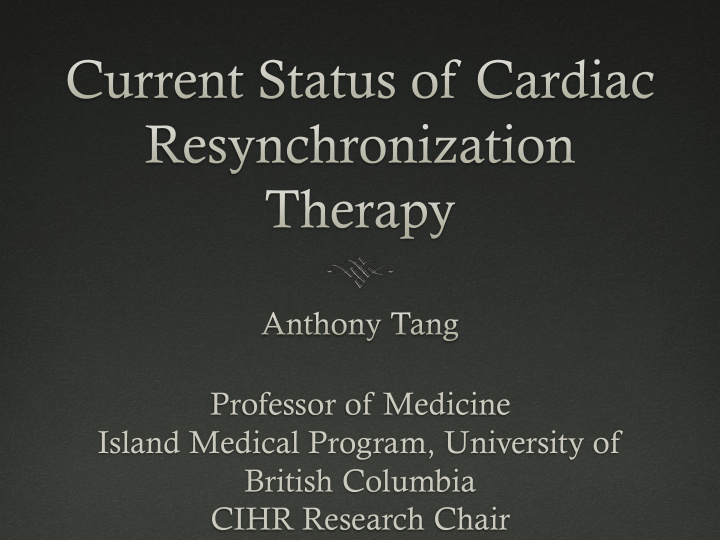



Professor of Medicine Island Medical Program, University of British Columbia CIHR Research Chair
Disclosure CIHR research chair (jointly funded by CIHR and Medtronic of Canada) Research fund (Medtronic of Canada, St. Jude Medical, Biosense-Webster) Honorarium (Sanofi- Aventis, Boehringer Ingelheim, Medtronic)
Case 1 48 yr old man Dilated cardiomyopathy NYHA class II heart failure symptoms Permanent AF – resistant to cardioversion and Amiodarone LVEF 25%, LVEDD 55 mm, LA 55 mm QRS duration 150 ms LBBB
Medication AF Managed with anticoagulation and good rate control Optimal HF medical therapy Carvadilol 37.5 mg BID Digoxin 0.25 mg OD Rampril 10 mg OD Spironolactone 25 mg OD Warfarin – INR 2-3
Which Device Therapy? ICD CRT-P ICD and CRT (CRT-D)
Patients With Reduced LV Ejection Fraction ACC Heart Failure Guidelines 2009 I IIa IIb III For patients who have LVEF less than or equal to 35%, a QRS duration of greater than or equal to 0.12 seconds, and atrial fibrillation, cardiac resynchronization therapy with or without an ICD is reasonable for the treatment of NYHA functional class III or ambulatory class IV heart failure symptoms on optimal recommended medical therapy. Heart Failure Society of America Guidelines 2012 CRT may be considered for some patients with atrial fibrillation More evidence is needed to guide the appropriate use of CRT in patients with AF
Comparative effects of biventricular and RV pacing in HF patients with chronic AF MUSTIC-AF C Leclercq et al EurHeartJ,2002;23:1780 – 1787
Response to CRT in Patients With Sinus Rhythm Versus Chronic AF Molhoek et al AJC 2004 94:1506
Mortality Molhoek et al AJC 2004 94:1506
Outcomes of CRT in Patients with versus Those Without AF: A Systematic Review and Meta-analysis Wilton, HR 2011;8:1088
Outcomes of CRT in Patients with versus Those Without AF: A Systematic Review and Meta-analysis Wilton, HR 2011;8:1088
The Importance of Performing AV Junction Ablation in Patients With AF M Gasparini, JACC 2006;48:734 – 43
Meta-analysis of CRT studies among AF patients with or without AVN ablation P value for the pooled RR 0.001 Wilton, Heart Rhythm 2011;8:1088
AV Nodal Ablation Predicts Survival in Patients with AF Receiving CRT Dong et al , HR 2010;7:1240
AV Nodal Ablation Predicts Survival in Patients with AF Receiving CRT Dong et al , HR 2010;7:1240
AV nodal Ablation Predicts Survival in Patients with AF Receiving CRT Dong et al , HR 2010;7:1240
Importance of Performing AV Junction Ablation in CRT Patients with Permanent AF Baseline Characteristic Gasparini EHJ 2008;29:1644,
Importance of Performing AV Junction Ablation in CRT Patients with Permanent AF Gasparini EHJ 2008;29:1644,
Importance of Performing AV Junction Ablation in CRT Patients with Permanent AF Gasparini EHJ 2008;29:1644,
RAFT – AF data In the RAFT study, patients with permanent AF were stratified at randomization Primary Outcome Sub-group analysis
Association of % Bi-Ventricular Pacing with Survival in 9,360 CRT-D Patients with AF Ousdigian et al, HRS meeting 2011
CRT for HF patients with Permanent AF Case-control studies suggest some benefit of CRT, but with less respond rate, less remodeling, and less mortality and morbidity outcomes benefit Limited randomized trial data RAFT provided the largest randomized trial data with only a signal of benefit; however, % pacing was low Planning a large randomized controlled trial
Case 2 65 year old man CAD – 2 remote MI; PCI – D1 and RCA Dyslipidemia, Hypertension LV EF = 28% HF – NYHA class II; Exertional dyspnea, lethargy, weakness Medications Metoprolol 37.5 mg BID Ramipril 10 mg OD ASA 81 mg OD Lasix 40 mg OD Sipronolactone 25 mg OD
ECG Sinus Rhythm QRS duration 210 ms
CRT ? Yes No May be
Kaplan-Meier Curves for QRS Morphology in Medicare Patients with CRT-D Bilchick, Circulation 2010;122:2022
Kaplan-Meier Curves for QRS Morphology in Medicare Patients with CRT-D Bilchick, Circulation 2010;122:2022
QRS Morphology and Cardiomyopathy Type in Medicare Patients with CRT-D Mortality rates based on QRS morphology Mortality Hazards Associated with QRS and cardiomyopathy type morphology and cardiomyopathy type Bilchick, Circulation 2010;122:2022
Outcomes in 61 Patients with RBBB in MIRACLE and CONTAK-CD Nery, HR 2010;8:1083
Independent Predictors of Mortality and Hospitalization in CARE-HF Gervais EJHF 2009;11-699
Effectiveness of CRT by QRS Morphology in MADIT-CRT Zareba, Circulation 2011;123:1061
QRS Morphology and Duration on the Effectiveness of CRT Patients with LBBB derived more benefit from CRT than Non-LBBB In patients with LBBB, there is a linear relationship between the effectiveness CRT and QRS duration; however there is no distinctive cut-point to differentiate effective versus non-effectiveness In patients with non-RBBB, QRS duration 160 ms is a good cut-point above which CRT is effective to reduce outcome of death or HF hospitalization
Recommend
More recommend